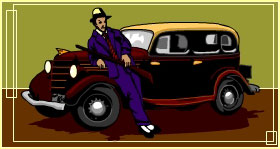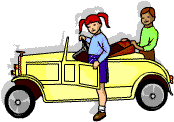The Art of Pavement Parking
Created | Updated Jan 28, 2002
 Parking used to be a case of swinging in towards the kerb and straightening up, to end up close to, and parallel with, the
Parking used to be a case of swinging in towards the kerb and straightening up, to end up close to, and parallel with, the
kerb. If the gap was small, one could use a technique called reverse parking1, i.e. pull up alongside the car in front of the
gap and reverse into the gap. But this is now considered old-fashioned and for wimps.
It is becoming increasingly trendy to park on pavements2. Its greatest exponents are even buying big four-wheel-drive jeeps
to enable them to get up even the largest of kerbs. In these vehicles it's referred to as off-roading. It would appear
that many believe they have a right to park on the pavement or at least with two wheels bumped up the kerb. Even double
yellow lines3 alongside the kerb do not deter the dedicated. This practise has reached such epidemic proportions that even
on a quiet and wide side street the art is still performed.
There are two main methods of pavement parking. One is to drive slowly towards the pavement until the near-side front tyre is touching the kerb, then apply power, whilst steering into the kerb until the front wheel climbs onto the kerb. Then continue deep onto the pavement, until the back near-side wheel also climbs the kerb, before swinging the front back round to straighten up. The second method is easier and is best for the novice, but does require the presence of a lower kerb. One simply drives the near side wheels up the lowered kerb. You can then drive along with two wheels on the pavement until the desire position is reached. Beware; on busy pavements pedestrians 4 may be slow to get out of the way, especially if they have their backs to you. Don't despair, a gentle toot on the horn usually does the trick.

Aside from this being illegal, it causes considerable inconvenience to pedestrians, which may be
seen by some as part of the attraction of the sport.
Pavement Parkers narrow the footpath to the extent that sometimes it
is necessary for pedestrians to walk in the road. Even partially blocked pavements can cause havoc especially to the
blind, wheelchair bound and to parents with pushchairs. If the pavement is wide such that not much hindrance is caused,
swinging the car door open into the path of passing pedestrians can add to the fun. Here timing is all-important to cause
maximum nuisance.
Pavements are often not build to withstand the rigours of being driven on, especially by lorries who also like to
participate. This can considerably add to the sense of achievement, as the pavements often crack and break-up under the
strain.
When darkness falls a new element is added. By parking against the flow and leaving dipped head lights on, the dipped beam
is cast to the centre of the road, not the kerb, thereby dazzling on coming traffic into the bargain.
Pavement Parkers come from all walks5 of life, and are not bad people. They are often misunderstood and accused of being one or more of the following:
1. Ignorant; They're just too stupid to realise that it is illegal and inconveniences others.
2. Incompetent; It's too difficult to park close and parallel to the kerb.
3. Lazy; The road is narrow and they can't be bothered to park in a more appropriate place and walk.
4. Misguided; There are yellow lines. They might be to stop parked cars causing an obstruction. By parking partly on
the pavement they feel that they reduce the obstruction and thereby reduce the offence (in fact they are now committing
two offences6).
5. Sheep7; Everyone else is parked on the
pavement therefore it must be the right thing to do.
6. Selfish; They just want to get on with their live and disregard everyone else.
To sum up they are ignorant, incompetent, lazy, misguided selfish sheep. They may be call much worse, but Pavement Parkers are
un-fazed by anything that may be said to them and are well versed in the allied art of giving verbal abuse.
increasingly rare breed of humans that actually walk to places other than to and from their cars5Perhaps 'walks' is not the right term.6 The author is not a legal expert, but believes that the yellow lines still apply and parking on the pavement
is an offence in its own right.7 Sheep are noted for following other sheep for no reason
